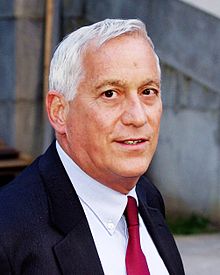Aspen Institute

The Aspen Institute is a US think tank based in Washington, DC with conference facilities in Aspen, Colorado and Wye Plantation, Maryland, and has an international network of independent branches in Germany, Italy, France, Romania, India and Japan. The current president and CEO is Walter Isaacson .
mission
According to its own account, the institute is a “non-partisan, private, non-commercial think tank that examines the most difficult questions of current politics” and addresses decision-makers from business, politics and science. Aspen recruits its employees from all academic and diplomatic backgrounds. Aspen's Wye Plantation Conference Center is known to the wider public for the peace negotiations that took place there between Israeli Prime Minister Ehud Barak and Yasser Arafat . The Aspen Institute Germany also sees its role in making "impossible meetings" possible.
history
The think tank was founded in 1950 by the American entrepreneur and German émigré Walter Paepcke (1896–1960) in the winter sports resort Aspen ( Colorado ), after he was inspired by Mortimer Adler at the University of Chicago through his seminar on "classic books". In 1945, Paepcke had visited the decaying mining town of Aspen in the Roaring Fork Valley of Colorado. Inspired by the beauty of the city, Paepcke came to believe that the city could be transformed into a conference center where artists, executives, philosophers and musicians could meet in seclusion from their everyday lives.
To realize this vision, Paepcke organized a celebration in 1949 on the occasion of the 200th birthday of Johann Wolfgang von Goethe in Aspen, Colorado, which was attended by over 2000 guests. Albert Schweitzer , José Ortega y Gasset , Thornton Wilder and Arthur Rubinstein came among others . The following year, Paepcke founded the Aspen Institute and later the Aspen Music Festival and the Aspen International Design Competition. Paepcke wanted to create a forum "where the human soul can blossom" in the middle of the hurricane of modernization. He hoped the institute would help industry executives return to the "Eternal Truths"; H. to anchor permanent ethical values in the day-to-day management of their companies.
For the construction of the Aspen Institute for Humanistic Studies, Paepcke hired the Bauhaus artist Herbert Bayer , who emigrated from Germany to the USA in 1938 and has been an architect there ever since. Together with Fritz Benedict and later Harry Ellenzweig, Bayer designed the central building of the Aspen Institute and shaped its modernist design language.
Inspired by Mortimer Adler's seminar on classic books, Paepcke founded the Aspen Seminar. In 1951, the Institute sponsored a national photography conference attended by many of America's most prominent photographers - Ansel Adams , Dorothea Lange , Ben Shahn, and Berenice Abbott , among others . In the 1960s and 1970s, the Institute added many new programs, notably the Aspen Strategy Group, the Aspen Institute Communications and Society Program, and the Congressional Program.
In 1961, two physicists, George Stranahan of the Carnegie Institute of Technology and Michael Cohen of the University of Pennsylvania, proposed the Aspen Institute to create a unique research center for physicists. In 1962 a new building was built on the property of the Aspen Institute in the west end of the city of Aspen and the Aspen Center for Physics was opened.
See also
Web links
- The Aspen Institute (English)
- Theo Sommer : 50 years of the Aspen Institute . In: Die Zeit No. 37/2000 .
Individual evidence
- ↑ so board member Joachim Krause , quoted. after: Meeting with Afghanistan's Northern Alliance in Berlin: Declaration by the Aspen Institute , January 13, 2012
- ↑ http://www.aspeninstitute.org/about/history
- ^ Aspen Meadows Reception Center | AspenModern. Retrieved October 29, 2017 (American English).
- ^ History . Aspen Center for Physics. Retrieved January 1, 2013.
